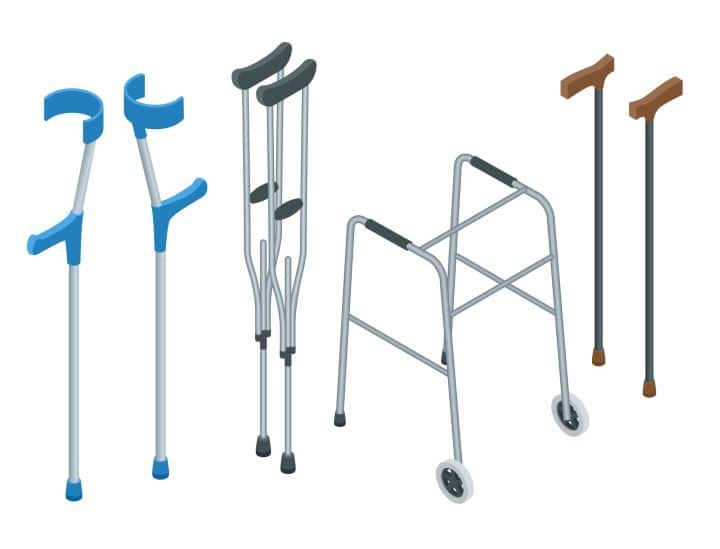Recovery after hip replacement surgery can be lengthy. Your daily activities could pose to be a challenge for about two weeks. It will take about six weeks before you can return to regular daily activities and about one year before a full recovery is completed.
During this post-operative time, you must take extra care of those joints. You will likely need quite a bit of assistance during those first six weeks. Part of that assistance will require either a walker, crutches, a cane, or a combination of the three.
You will be up and walking within 24 hours of the surgery. Your surgeon will ultimately give you their recommendation for your recovery. If you are looking to prepare ahead of time, I have written this article to break down how to decide if you will be using a walker, crutches, and/or cane for your recovery.
First, let’s talk about walkers
There are 3 main types of walkers; a non-rolling walker, a 2 wheeled front rolling walker and a 4 wheeled rolling or rollator walker.
Of these, the 4 wheel rolling or rollator walkers are the most maneuverable and versatile. If you are going to choose a rollator walker, you should look at your specific requirements.
There are different rollator walkers meant for tall people and bariatric patients. You can also get an upright walker to keep you erect while walking. If you’d like the option of sitting down after some time, a rollator walker with a seat is your best bet. Finally, if you are going to be outdoors, you can look at rollator walkers for rough surfaces.
You will be instructed by your doctor or physical therapist as to which walker would best suit you. You may only use a walker for a short period of time as you are getting more comfortable on your feet.
The video below shows how to properly use the 3 different kinds of walkers.
Here are the 3 steps to using a walker:
- Move the walker a few inches forward
- Shift your weight on to the walker, Step into the center with the side that has been operated on.
- Step forward with your good leg. Repeat.
Many previous patients suggest using a walker for the first few days. The walker can provide a sense of balance while you start to navigate the beginning stages of healing from your surgery.
A front-wheeled walker will allow you to disperse your weight evenly on both sides. It will also allow you to lean on if you are feeling not so confident on your feet.
Some patients do claim that it is difficult to move around small spaces with a walker. Because the walker is wider than a cane or crutches, you could feel restricted to the number of places you can get around comfortably.
Another potential difficulty might be stairs. Depending on the walker you choose, it may be easy or not easy to fold and lift between flights of stairs.
Consider your living conditions and how much help you will have in the first few days. Some walker users do say that they find their hands and arms hurting after extended use.
Leaning on the walker for long periods of time could also end up hurting your back. If that’s the case, perhaps being more upright would be the better option for you.
You may also like Is a Knee Scooter Better than Crutches?
Now, what about crutches?
You may transition to crutches or a cane after using your walker for a short period of time. You will always want to check in with your doctor or physical therapist before transitioning to a new apparatus.
Here are the steps for how to use crutches safely and effectively:
- Lean on your hands, not on your armpits. This is a common mistake that many people make.
- Move your operated leg/hip forward at the same time as the crutches. Be sure to keep this leg in line with the crutches for support.
- Keep looking straight ahead as you walk and continue to step forward while alternating your legs.
- Take small steps forward.
Take extra precautions while using the stairs. You will want to hold the railing with one hand and hold both crutches in the other hand.
If you are going to be using crutches, this instructional video on how to use them can be of great help.
Crutches seem to be the least favorite of all apparatuses among patients. Crutches can be awkward to learn to use even if your legs are working properly. They tend to wobble and be awkward to balance on. Other challenges with crutches include learning how to turn corners, open doors, and the use of stairs.
You may also like Best Cane for Balance Problems
Next up, canes!
Canes are a very popular choice after hip replacement. Depending on your surgeon, you may be recommended to start right away with a cane. Canes can be great if you already have a good sense of stability but need a little bit of extra assistance.
It is not uncommon for canes to be used in conjunction with the use of walkers or crutches. If you are moving around the house, you may prefer the cane; however, if you are going to be out for a longer period of time, you may enjoy the walker’s stability.
This video explains how to use a cane properly.
Many first-time cane users do not use the proper technique that is recommended by physical therapists. Contrary to what many people may think, you will want to use the cane on the side of your NON-operated leg. The reasoning for this is that you want to add more stability to the side you already have stability on.
The purpose of the cane is not to replace your operated leg. The purpose is to gain balance. You will want to move your cane and your operated leg at the same time. This will take practice.
Let’s be realistic. You may have the perfect recovery planned out, and it may not go at all the way you expect it to. Alternatively, you may be dreading the recovery, only to find out that you have it easier than anticipated.
Your age, your weight, and the protocol of the hospital can all make a difference regarding the speed and ease of your mobility. Avoid making a concrete decision about your method of an assisted device before consulting with your physician and assessing how your body feels.
Hip replacements are one of the most successful operations in medicine today. A hip replacement can change your life. Many patients that have had this surgery claim that their quality of life has greatly increased following their procedure.
With proper care and some physical therapy, you will be returning to an active lifestyle in no time. Always make sure you check with your physician and physical therapist before making any final decisions on how you choose to recover. I wish you all the best.




